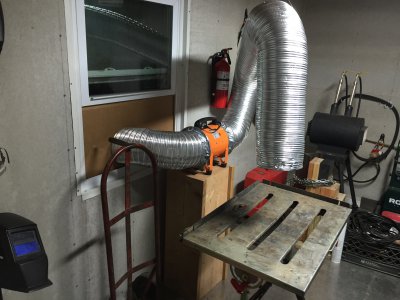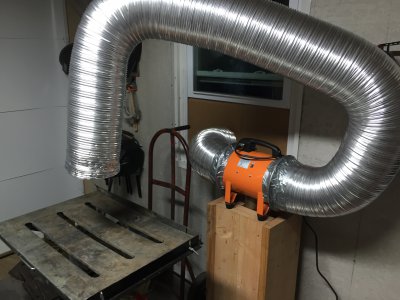O
ome
Forum Guest
Register Today
Hi Guys,
I have been welding outside the last 4 months, now with the rain, need to move my practice sessions inside
 shed.
shed.
Here is what I am working with.
Lean -to shed -10' wide by 14' deep with welding table by one window on higher side, which is about 10' inside, with all walls covered with 1/4" cement board and alum flashing covering other interior spaces.
Only the ceiling is not covered.
Harbor freight ventilator:
3300 rpm, 1590 cfm hi, 1380 cfm low 1.4 amps
8 " but with flange is 9.75".
We have 8" alum flex pipe , and another window open, with window fan blowing in, across from window with vent pipe going out.
Two 10' tall doors , each 3' wide, usually closed or one door opened, depending on direction and intensity of rain.
I need some advice as to where to buy some adapters out of tin or ss, to connect the 8" flex alum pipe to the 8.25" neck just past the 9.75 flange on the exhaust port of the ventillator. Same is neede for the inflow side of the 8" to ventilator( both sides the same measurements)
And a sizeable hood (12" by 8") to pick up over my table when welding. All with the 8" flex alum pipe.
We set up a mock prototype with duct tape as joinery.
Worked ok, but some smoke escaped the 8" pipe hanging 12" over weld area.
What would work to be able to use clamps so is more permanent, but can be broken down easy if needed?
Where can I get these, or have them made.
I do not have the experience to even try to fabricate them.
Here is a pic,
Thank you in advance for any advice ,
Ome
I have been welding outside the last 4 months, now with the rain, need to move my practice sessions inside

 shed.
shed.Here is what I am working with.
Lean -to shed -10' wide by 14' deep with welding table by one window on higher side, which is about 10' inside, with all walls covered with 1/4" cement board and alum flashing covering other interior spaces.
Only the ceiling is not covered.
Harbor freight ventilator:
3300 rpm, 1590 cfm hi, 1380 cfm low 1.4 amps
8 " but with flange is 9.75".
We have 8" alum flex pipe , and another window open, with window fan blowing in, across from window with vent pipe going out.
Two 10' tall doors , each 3' wide, usually closed or one door opened, depending on direction and intensity of rain.
I need some advice as to where to buy some adapters out of tin or ss, to connect the 8" flex alum pipe to the 8.25" neck just past the 9.75 flange on the exhaust port of the ventillator. Same is neede for the inflow side of the 8" to ventilator( both sides the same measurements)
And a sizeable hood (12" by 8") to pick up over my table when welding. All with the 8" flex alum pipe.
We set up a mock prototype with duct tape as joinery.
Worked ok, but some smoke escaped the 8" pipe hanging 12" over weld area.
What would work to be able to use clamps so is more permanent, but can be broken down easy if needed?
Where can I get these, or have them made.
I do not have the experience to even try to fabricate them.
Here is a pic,
Thank you in advance for any advice ,
Ome

